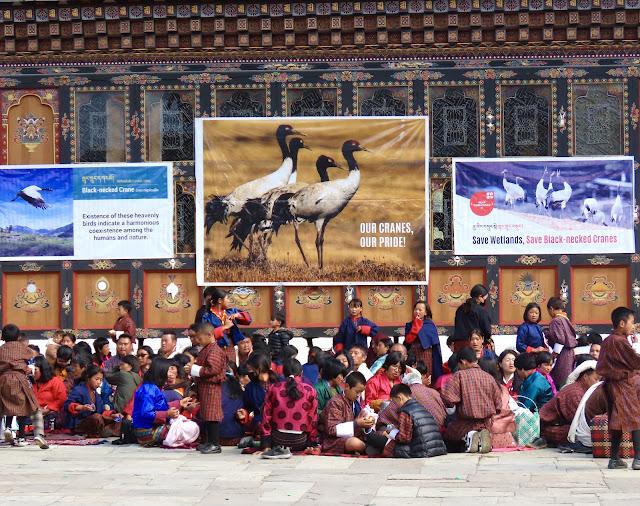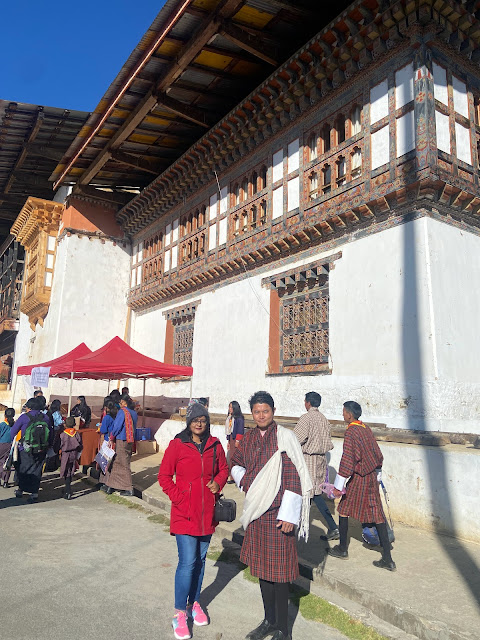 |
| The statue of black-necked cranes at the Gangtey Monastery courtyard, Phobjikha Valley, Bhutan. |
If you wish to explore human-wildlife bonding up close and personal, do visit Bhutan's Phobjikha Valley on November 11. On this day, the local people of the valley and the monks of the Gangteng Monastery sing and dance in a celebratory event like no other called the "Black-necked Crane Festival" to welcome migratory black-necked cranes to their ethereal valley. This one-day event, held in the courtyard of the age-old Gangteng Monastery, embraces all visitors, local or foreign, with its splash of colors, mysterious and melodious Bhutanese folk songs and dances, and a spiritual ambiance unique to the high mountains of the Himalayas. This year, I was one of those few fortunate to have the opportunity to attend this festival in this slice of heaven on Earth, and hence, I am presenting it to you all below:
The Stars Of The Show
 |
| An injured black-necked crane in that the Black-necked Crane Information Centre in Phobjikha Valley, Bhutan. |
The Black-necked Crane Festival, although started more recently in November 1998 as a one-day annual event, actually celebrates an age-old bond between the people of the Phobjikha Valley and the black-necked cranes they regard as beings from heaven. Called the thrung-thrung karmo in the local Dzongkha language, the arrival of these regal visitors from the remote Tibetan Plateau around late October is regarded as a good omen - a symbol of prosperity and fertility. As such, these birds heavily feature in the region's folklore, and traditional songs, and dances.
 |
| The Phobjikha Valley, Bhutan. |
In Bhutan, Phobjikha in Wangdue district and Bomdeling in Trashi Yangtse district are the two primary wintering destinations for these winged beauties. Phobjikha, a U-shaped valley at an elevation of around 3,000 m, around four hours drive from the national capital of Thimpu, hosts the highest number of these birds among these two, with last year witnessing the arrival of nearly 600 black-necked cranes to the valley. It is said that these birds, upon their arrival between mid-October and early December, circumambulate the Gangtey Monastery three times and repeat the same act when returning to Tibet between March and mid-April. While they stay in the valley, their presence is a constant source of joy to the people of Phobjikha and numerous international travelers who tread long distances just to witness these marvelous birds and the festival dedicated to them.
The black-necked crane is the world's only alpine crane species and charms all with its elegant appearance and graceful moves. A bright red patch adorns its otherwise black head, while its neck and tail are also jet black, contrasting its ashy gray body. Numbering only just over 6,000 mature individuals, this Near Threatened species breeds in the Tibetan Plateau of China and remote parts of Ladakh, India, and winters at lower, warmer altitudes in some parts of Bhutan and Arunachal Pradesh, India.
In its wintering habitat in the Phobjikha Valley, the black-necked cranes feed on harvest residues in the region's agricultural fields as well as dwarf bamboo and other vegetation growing in the wetlands of the valley, along with a range of invertebrates, frogs, fish, lizards, and more. A large section of the valley is designated as a conservation area to keep the birds safe while potato cultivation flourishes in the other parts of the valley, which, along with tourism, form the backbone of the local economy.
A Festival To Win Hearts And Save Lives
Unlike the fairytales associated with the black-necked cranes ending in a happily ever after, the life of these cranes is riddled with many challenges. While natural predators like leopards, foxes, and small wild cats prey on these birds across their range, humans have bigger, fiercer, and catastrophic impacts on their survival rates. Throughout their range, drainage and conversion of wetlands into human settlements and agricultural lands, construction of dams, diversion of rivers and streams for human use, livestock overgrazing, peat mining in wetlands, egg collection for consumption, predation by domestic dogs, etc., are some of the many threats that growing human presence pose to the survival of these birds.
But the people of Bhutan, always at the forefront of environmental conservation, realized the need to protect the birds from such adverse human impacts quite early on. In 1998, the Royal Society for Protection of Nature (RSPN), a national NGO, organized the first "Black-necked Crane Festival in the Phobjikha Valley. Initially held near a school building, the festival venue was shifted to the impressive and historically and religiously significant Gangteng Monastery in 2005.
The aim was to revive the ancient connection between the people of Bhutan and these birds and promote domestic and international tourism to create an environment where the local communities would become the protectors rather than the destroyers of the birds. The wisdom of RSPN worked, and soon, the festival became a huge success. The inflow of income from growing tourism in the valley due to the presence of the birds and the allure of the festival supplemented the income of the locals, encouraging them to protect the birds and their wetland habitat in the valley.
 |
| The Black-Necked Crane Visitor Center in the Phobjikha Valley. |
A Black-necked Crane Visitor Center was also set up in the valley to provide locals and visitors an opportunity to learn more about the black-necked cranes. The Centre can be visited today and is equipped with telescopes and spotting scopes to view the birds in the valley. It also showcases a 15-minute documentary at regular intervals related to the conservation of these birds in the Phobjikha Valley and has numerous displays providing an in-depth understanding of these birds to those interested to learn more about them.
Black-necked Crane Festival, 2023
 |
| Local families during the lunch break at the Black-necked Crane Festival 2023 in the Gangtey Monastery, Bhutan. |
This year was the 24th celebration of the Black-necked Crane Festival. To me, witnessing this festival happening before my eyes was a dream come true. The event was held on November 11, a day regarded as auspicious by the Bhutanese people as it coincides with the birthday of their fourth King, Jigme Singye Wangchuck.
By 9 am, the courtyard of the Gangteng Monastery was choc-a-bloc full of spectators, including local people and foreign tourists. Foreigners had to pay an entry fee at the gate of the monastery. For Indians like me, it was only INR 250, but higher for visitors from other countries.
 |
| With my very knowledgeable guide from Bhutan, Guru, at the Gangtey Monastery to attend the Black-necked Crane Festival, 2023. |
The impressive monastery architecture, the surrounding lofty Himalayan peaks, and the vibrant costumes of the local people and festival performers all made for a very cheerful sight. After the ceremonial blessing by the monastery head and initiation Buddhist rituals, the songs and dances began one after the other, each a treat to the eyes and ears of the spectators, and continued till the evening, only interrupted by a small lunch break of 45 minutes.
Performers included school and college children, monks of the monastery, and local men and women - all draped in colorful traditional costumes that are a photographer's delight. While every program charmed the audience, the crane and mask dances grabbed the spotlight.
Crane dances, performed by students, surrounding the statues of an adult and juvenile black-necked crane, served as a gesture of love and reverence of the local community of the Phobjikha Valley toward the winged visitors of their valley.
 |
| A mask dance performer at the Black-necked Crane Festival, 2023. |
The mask dances, or Chaam in the local language, were sacred dances linked to Buddhist religion and spirituality with elements of both the powerful and the mysterious. Also adding a lot of humor to the festival were balloon fight events and the act of the Atsaras, clown-like performers who are also believed to play important spiritual roles.
 |
| Posing with an Atsara at the Black-necked Crane Festival 2023, Bhutan. |
At the end of the day, it was just exciting to think that the source of all this mirth and merriment, the smiles on so many faces, was the arrival of the black-necked cranes in the Phobjikha Valley. It was truly a celebration of conservation - an inspiration for those working hard to reverse the adverse impacts of growing human populations and aspirations on environment and wildlife.
Written by: Dr. Oishimaya Sen Nag
All videos and photos (except for those credited otherwise) by: Dr. Oishimaya Sen Nag


Hello! I just finished reading your articles and some short videos,wow it’s just amazing and I really loved the way you wrote articles, it’s very clean, short and off course very informative points.I’m very proud of you mam and lucky to be your guide.so keep on writing articles and hope to see you once more in Bhutan!!! KADRINCHOE LA
ReplyDeleteThank you for the feedback. Glad you liked the article.
DeleteSpectacular n awesome event. Written with great ease.
ReplyDeleteThank you.
Delete